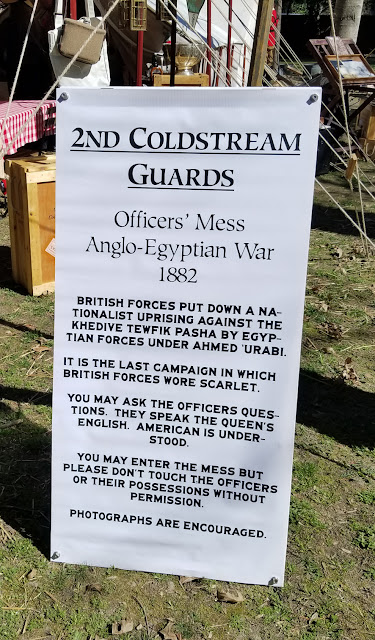Military History Through the Ages 2024
I've attended this huge reenactor exhibit at the Jamestown Settlement Museum several times over the past few years and always find something new and interesting each time. This year I found three Polish reenactor groups I'd never noticed before. First, and historically oldest, was Sobieski's Vanguard from 1683.
This group, in period garb, displayed the unique feathered armor worn by Polish Winged Hussars under King Jan III Sobieski during their victory over Ottoman Turk forces during the 1683 siege of Vienna.
One of the reenactors posed next to chain mail armor worn by the infantry while other reenactors sat in the tent behind.
Moving forward through history by more than two centuries, another group portrayed Polish soldiers in World War II.The slogan on this displayed poster (according to Google Translate) says, "To Arms! Together and united we will overcome the enemy."
I noticed the Polish word, Ulhan, in the title on the left poster top. Google Translate says it means, "12th Podolian Lancer Regiment". This evokes a memory of my great grandfather, Jan Ostrokolowicz, who I know only from this late 1800's picture. According to writing on the photo, he poses in the uniform of the Polish Ulhani "Organization".
Perhaps the reenactors were portraying the same regiment my great grandfather served in about 50 years earlier than 1939.
Another group portrayed heroic Polish fighters shortly after World War II. Their sign says Brygada Smierci, or Death Brigade. This underground partisan brigade fought against communist takeover of Poland, but were ultimately defeated. The unit originated and operated around Vilnius in Lithuania which explains the image of Our Lady of the Gate of Dawn displayed on the flag at the reenactor site. This icon from the 1600's was mounted above the Vilnius city gate and was believed to have miraculous power against enemies.
A final group that captured my interest was the 2nd Coldstream Guards from 1882 whose display of authentic British Victorian aristocratic life was palpable.The officer's mess, called the Djin Club, illustrated upper class military camp lifestyle. In particular, check out the elaborate table setting by enlarging the last of the following three pictures.
Looks like officers lived quite comfortably during this campaign! The next two pictures show an officer's tent with contents that seem to be delivered into the present by a time machine! One of the reeanactors showed me how all the tent contents could be folded up into small portable rectangular packages. Many of these wooden cases had beautiful inlaid brass decorations. Enlarge the second image to see what the time machine delivered.
Here is the officer's mess "kit".I imagined a good number of servants or ordinary soldiers were required to pack up and transport all the equipment needed to keep officers comfortable. When I asked the reeanactor how ordinary soldiers lived he told me one smaller round tent nearby might house 12 or more soldiers who would sleep on the ground with bodies arranged like spokes radiating from the center tent pole. No fancy beds, tables, dining clubs, or sweets for them, apparently. So it was great to be an aristocraic upper class officer in this military unit, but not so great to be an ordinary soldier.


















No comments:
Post a Comment